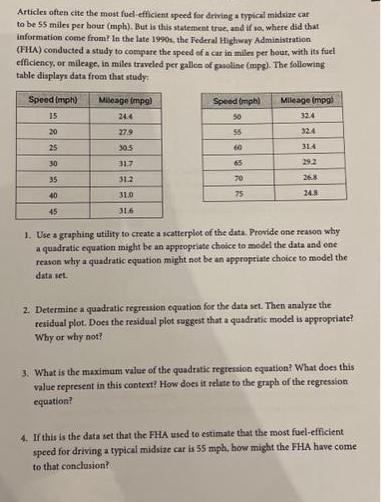Answered step by step
Verified Expert Solution
Question
1 Approved Answer
Articles often cite the most fuel-efficient speed for driving a typical midsize car to be 55 miles per hour (mph). But is this statement

Articles often cite the most fuel-efficient speed for driving a typical midsize car to be 55 miles per hour (mph). But is this statement true, and if so, where did that information come from? In the late 1990s, the Federal Highway Administration (FHA) conducted a study to compare the speed of a car in miles per hour, with its fuel efficiency, or mileage, in miles traveled per gallon of gasoline (mpg). The following table displays data from that study: Mileage impg) Speed (mph) 15 20 25 30 35 40 45 24.4 27.9 30.5 31.7 31.2 31.0 31.6 Speed (mph) 50 55 60 65 70 75 Mileage (mpg) 32.4 32.4 31.4 29.2 26.8 24.8. 1. Use a graphing utility to create a scatterplot of the data. Provide one reason why a quadratic equation might be an appropriate choice to model the data and one reason why a quadratic equation might not be an appropriate choice to model the data set. 2. Determine a quadratic regression equation for the data set. Then analyze the residual plot. Does the residual plot suggest that a quadratic model is appropriate? Why or why not? 3. What is the maximum value of the quadratic regression equation? What does this value represent in this context? How does it relate to the graph of the regression equation? 4. If this is the data set that the FHA used to estimate that the most fuel-efficient speed for driving a typical midsize car is 55 mph, how might the FHA have come to that conclusion?
Step by Step Solution
★★★★★
3.47 Rating (157 Votes )
There are 3 Steps involved in it
Step: 1

Get Instant Access to Expert-Tailored Solutions
See step-by-step solutions with expert insights and AI powered tools for academic success
Step: 2

Step: 3

Ace Your Homework with AI
Get the answers you need in no time with our AI-driven, step-by-step assistance
Get Started


